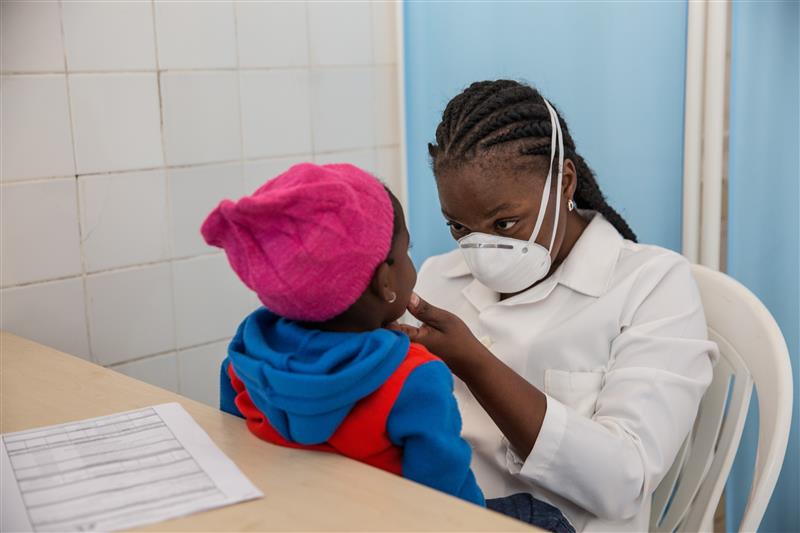At a glance
Children orphaned due to HIV/AIDS have an increased risk of developing and dying from TB. In 2022, CDC and partners began integrating TB diagnostic and treatment services into established orphan and vulnerable children programs in Uganda. Stopping the spread of the disease at its source is essential to safeguarding the health of Americans.
Finding the missing cases

Ricardo Franco
Children orphaned due to HIV/AIDS often live in more crowded households, lack appropriate nutrition, and have limited access to healthcare, increasing their risk of developing and dying from TB. Despite the known risks, data on finding TB cases among these children is limited.
Recognizing the need to protect orphans and vulnerable children (OVC), in early 2022, CDC partnered with Baylor Foundation Uganda to transform TB case finding by integrating services into established OVC programs. This innovative approach, first applied in the Rwenzori Region of Uganda, has led to a remarkable increase in TB diagnoses among OVC and their household members.
Before the project, TB screening relied on passive methods – only considering TB when children were severely ill or reported specific symptoms. Spotting this gap, CDC initiated a project that integrated comprehensive TB services into existing OVC programs serving more than 19,000 OVC and caregivers in Uganda. The goal is to enhance TB screening and improve prevention and treatment outcomes. The project demonstrates the power of community-based healthcare and marks a significant step forward in protecting the health of children.
Improving TB outcomes
CDC and partners provided critical TB services such as health education, screening, sample collection, referrals to health facilities, diagnosis follow-up, and counseling for treatment. TB screening, evaluation, and diagnosis increased substantially with OVC program integration and community outreach.
- Increase in Screening: Only 31 percent of OVC and caregivers were screened for TB before the project. This figure increased to an astounding 98 percent, showcasing the effectiveness of proactive outreach.
- Rise in Diagnosis: There was a 12-fold increase in diagnoses, particularly among younger children, highlighting how targeted outreach can uncover cases that would otherwise remain hidden.
- Treatment Completion: An outstanding achievement of this project was that 100 percent of those diagnosed with TB successfully completed their treatment.
- Preventive Measures: Additional TB diagnoses among adults living closely with OVC ensured they were treated, preventing further disease spread within households and the community.
Voices from the field
"Our children are not catching TB anymore, because you have taught them how they can protect themselves. Even when they do get TB, they are treated quickly now and saved."
- Project Officer
Staff overwhelmingly found the intervention successful in diagnosing more TB cases, encouraging treatment completion, and raising awareness. A community worker shared how the intervention had multiple impacts, "Definitely (our service) improved. Of course, there has been an increase in the number of TB cases we identified, but also an increase in the number of (treatment support) follow-ups for TB cases, an increase in TB contact tracing, and an improvement in terms of TB preventive treatment (TPT) to prevent those who have been in contact with the TB cases."
Two families passionately stated, "Had you not reached us and advised us to come for services, we should have died," reflecting the life-saving impact of these services.
A model for future strategies
Integrating TB services into OVC programs is cost-efficient, feasible, and transformative, amounting to only $0.87 per person reached during the twelve-month program. This inexpensive integration of TB services protects children, reduces cases, and stops further transmission.
The impact of integrating TB services into OVC programs extends beyond immediate health outcomes; it serves as a model for future public health strategies. The findings underscore the necessity for the integration of targeted interventions that address the unique needs of populations at greatest risk.
A Vision For Ending TB
Uganda is making significant strides toward reducing the TB burden among OVC. By leveraging community resources, fostering trust among families, and implementing proactive screening measures, this project increased diagnoses to help ensure that every child has access to life-saving TB treatment.
The data collected serves as both a benchmark for progress and a roadmap for future efforts. By addressing gaps in awareness, testing, and treatment – especially among populations at greater risk – the global community can work towards eliminating TB worldwide and in the U.S.
This is a testament to what can be achieved when innovative strategies are employed alongside dedicated community support – ultimately paving the way toward a healthier future free from TB.
